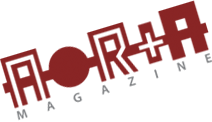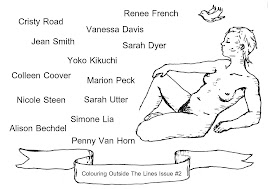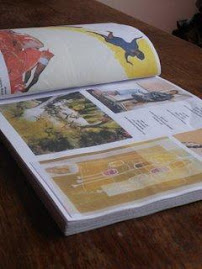
Lauren Carney is an amazingly friendly artist, illustrator and crafter from Brisbane, Australia who constantly made me giggle while we were setting this interview up!
Website: www.laurencarneyart.com
Blog: www.laurencarneyart.blogspot.com/
Etsy: www.etsy.com/shop/dizzylittledotty

How are you? What are you working on at the moment?
I’m really well, thanks for asking! I’ve been quite a busy little bee over the past few weeks! I’ve got a group exhibition coming up next week, so I’ve been trying to finish off some large water-colour pieces for that! Then the weekend after I have the Finder Keepers Spring Markets on, where I will be selling my wares and meeting very lovely art folk! Crazy right?
How would you describe your art?
The content of my work is whimsical and curious. Romanticism plays a large underlying theme and I think that is portrayed by the fanciful characters within each illustration. My artwork touches on a variety of mediums, mostly traditional mixed with digital illustration. The linework is messy but heavily detailed, the colours are bright, and the subject matter is a quirky!
A lot of the characters in your work are very cartoon looking (a good thing!), are you a fan of comics?
I’ve never been that into comics, but always wish that I had been! I was never really able to get my hands on them as a kid, because I grew up in a small town with a shortage of cool comic books in general. However I did have a huge cartoon fixation from my younger years, and that has stuck with me to adulthood! So I think that has a strong influence over me to this day!
What puts you in the best mood for drawing?
Well I have a confession, just of late I’ve been watching Coraline and Fantastic Mr Fox each day to get me through my creative block! I’m pretty sure I watched Coraline fifteen times last week – I’m a little bit addicted. But hey, I churned out eleven paintings that week, so it must have worked? But apart from obsessive movie watching, I generally sit down with a cup of tea in the morning, and look over my favourite blogs, with some Neutral Milk Hotel playing in the background. Then I’m good to go!
What materials do you most often/ most enjoy working with?
Moleskin Art Diary, A 0.005 Art-line Pen, Watercolour paints and different textured papers.
How did you first get started in art, is it something that you’ve always been interested in and excelled at?Were you always good at art at school, and did you study art beyond school?
I’ve always been really into art! I used to make my own mini zines as a kid, and home-made graphic novels! Hah, they were epic too! I’m pretty sure I decided when I was six I was going to do something creative career wise! In high school I finally made my mind up to do a Bachelor of Animation at Queensland College of Art in Brisbane. I really enjoyed it, and was a total claymation/stop motion fiend, but preferred illustration more (maybe because there is less work? Who knows!) It was a really good degree, and the knowledge I learned from there I can apply to doing illustrations and design program work on the computer!

How and why did you move to making art professionally? How did you gain the confidence (in yourself and your art) to do this?
Getting the confidence was a three year process, I didn’t enjoy my artistic style in University, so didn’t really take it seriously until after I graduated. I remember sketching and thinking “This style just isn’t me, it’s not reflecting who I am as a person”. I started getting into a routine where each day I would draw something new and progressively created a style that I now can comfortably call my own. I decided that I had to be more proactive with ‘getting my art out there’, so did a lot of local art markets, emailing magazines, creating a blog / website / facebook page and generally trying to learn as much as I could from other successful indie designers!
How representative of you is your work? I ask this, as just by looking at your work I have a little inkling of what I think you must be like as a person!!
Ha ha! I would say there is a little piece of me in each drawing! I’ve found this balance in life, and I feel it shows in my work. I can embrace being awkward, messy, nerdy and a little bit odd. It’s something that lots of people can relate to. I want my images to convey a sense of nostalgia, show love and the importance of appreciating everyday life. I’m on the small side of things, so like to draw my people that way. The girls are cheeky with tiny boobs, and the fellows sport bow ties and skinny jeans!
Your work has been featured in a lot of independent magazines (such as Charlie, Yen, Thaw, and Peppermint), are these magazines that you read personally, and as such how important to you is featuring within them?
Oh gosh yes! It’s so nice to be a part of something that you admire and adore! It’s so lovely being recognised for your hard work through different mediums, but to be able to hold in your hand one of your favourite mags with your own work captured within the pages – well, it’s a pretty awesome two in one!
The magazines aren’t solely art-focused magazines (I saw, for example, that in Charlie magazine your illustrations were part of a fashion spread), how important to you is meshing alternate aspects of art and culture together, and increasing exposure to art and illustration by it being used in less art-only/gallery-only spaces?
It’s so important to not put yourself in one box or category – metaphorically speaking. Design is incorporated into our everyday lives, we just don’t notice it half of the time. I’m trying my hardest to do the corporate stuff, along with the fun things and artistic integrity in the process.
I think the good thing about having an artistic nature is that you can apply it to heaps of different things, books, advertisements, gallery exhibitions, magazine spreads, clothing items, catalogues, game design – the list is endless really, its just being proactive and trying to pursue as many avenues as you can!

You have an upcoming exhibition in a joint show at White Canvas Gallery in Queensland.
What work have you created for the show? – Has the experience of preparing for a gallery show been different to how you usually create work?
Are you excited for the opening?
Oh I am so excited! I have emailed so many people – blogland friends, art friends, and some of my favourite shops around Brisbane! I’ve dropped off letters and sent bulk text messages – and those are the easiest jobs! Two of the artist’s Mark and Elizabeth have done all the organising for it, so I’m really learning a lot from them about how to go about getting ready for an exhibition! I thought it would kind of be like a high-school or university group assignment, where the deadline draws closer and the anxiety sets in, but its so not like that! It’s almost like a mini celebration, where you get to play show-and-tell with friends and art fans.
I’ve managed to whip up eleven mini A5 water-colour artworks, and three bigger pieces for the show! I feel that my work is better in person, because you can see the detail up close, whereas the detail isn’t as effective viewed on computer monitors! I usually upload pictures onto my blog when I finish them, but I’ve had to hold off for ages, and not show anyone, so I feel like I have a mini secret that is ready for sharing come Friday 29. Eek!
What keeps you motivated?
Hah, mostly coffee. Inspiration and motivation generally go hand in hand though. Ultimately artists inspire other artists. It’s amazing how another’s work, whether it be photography, painting, music or sculpture, can impact on you. I need daily inspiration to function. So I definitely take a coffee break once or twice a day and look through things that I know will keep me creatively going!
Your artwork can be crazy-intricate, even your journal pages are chocked full of detail. How important to you is attention to detail?
To me it’s pretty important. I just have this thing where stuff has to look busy, even if its simple, there still has to be little etchings, stitch marks, hair detail, freckles; all stuff that seems pretty insignificant but is rather important! I know when I look at drawings that are busy, I’m lured in, and it captivates me for a longer time frame than something plain would. So that is how I justify my busy pictures!
My favourite pieces of yours are the ones that feature the little ladies in their various kick-ass fashions looking super rad and hella cute (seriously, eyelashes and rosy-cheeks drawn in the way you do it will always make me swoon! And I’m a huge fan of well-drawn hair!), and also the ones that incorporate text and typography.
What inspires you to draw girls like these?
Hah, why thank you! It’s a well-known fact, that all kinds of folk, regardless of sexual orientation or gender, can appreciate the appearance a classy well-dressed lady!
The way someone dresses can tell so much about his or her personality. You get this real sense of individualism when you catch a glimpse of some people, based upon their clothing. I really try to capture the same thing with my little drawn ladies, because not all women are the same, it’s the shoes, the hair, the lashes, the odd glasses or array of freckles and personality that vary for each girl, so I try to convey that when I draw.

What sort of aesthetic things do you like; for example where do you work from, and what images/artefacts keep you company in your studio / place(s) of work?
I work in a nicely decorated office from home. On my desk you will always find no less than two coffee cups, a darling assortment of stationary, a gigantic mac and wacom drawing tablet. But apart from the boring essentials, I have my James Jean / Courtney Brims / Anke Weckmann postcard collection plus Frankie Posters creeping up my walls, A Wooden Toy magazine handy in case of emergency artists block, and the occasional bunch of flowers to make me feel out-doorsy.
Are you a collector/coveter/admirer of other artists’ work?
Hah, I seem to have this increasing amount of Dave Collinson work adorned around my household! I also have this stash of Miyazaki goods that keep on growing. DVDs, books, other bits and bobs. Haha. I would however, enjoy accumulating a collection of plushies like the ones Cat Rabbit creates. Then I could say “My name is Lauren, and I am a collector of friends, tea cups, art paraphernalia and fancy dressed plushies” I think I could win hearts with that one liner.
Who are your favourite artists that you could tip us off about from your native Australia?
Oh gosh, I have so many! Dave Collinson, Mel Stringer, Charmaine Olivia, Audrey Kawasaki, along with street artist’s Ghost Patrol and Creepy.

Beyond illustration you’re also a crafter. What to you enjoy about this form of creativity?
I think it takes me to a happy place from when I was younger! Oh nostalgia! I was always stitching, knitting and sewing in primary and high school, but didn’t really go any further with it until I realised it is quite fashionable to dabble in nanna-esque hobbies. I kind of put my own swing on it though, incorporating my love of drawings with hand made products!
What for you are the most enjoyable or rewarding aspects of working as an artist?
I think it would definitely be the way my work impacts on people. I love having a stall at markets because I can see their reaction in person. It sparks a little bit of curiosity at first then a giggle. It’s nice to know that my artwork can connect with people in that sense.

































